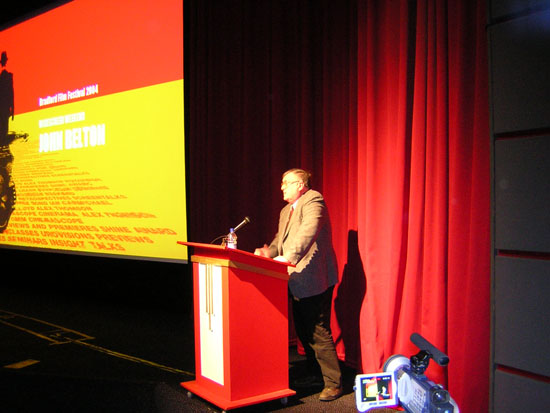Widescreen Weekend 2004
|
Read more
at in70mm.com The 70mm Newsletter |
|||||||
| Written and photographed by: Thomas Hauerslev | 6. April 2004 | |||||||
Thursday 18 March, 2004 |
||||||||
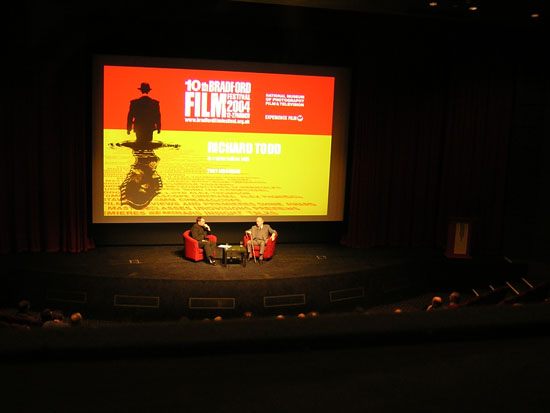 19:00 - Screen talk: Richard Todd, moderated by Tony Earnshaw. I arrived too late to listen to it. There was a big crowd. Mr. Todd was
reminiscing about “The Longest Day”. Outside it was raining.
19:00 - Screen talk: Richard Todd, moderated by Tony Earnshaw. I arrived too late to listen to it. There was a big crowd. Mr. Todd was
reminiscing about “The Longest Day”. Outside it was raining. 19:45 – “The Longest Day” (2:49). Filmed in black & white CinemaScope and blown up to 70mm for the London re-issue June 6, 1969 (25th anniversary of the invasion). 70mm print shown in 6-track magnetic stereo on the flat screen. Due to the age of the print we had two unscheduled stops during the beginning reel. Nice directional dialogue, flyovers and effects and a 15 minutes intermission. |
Further
in 70mm reading: Widescreen Weekend 2004 • Gallery: 2004 • Gallery film: 2004 • Gallery: Rayton • WSW Home • Through the Years • The Best of WSW • Academy of the WSW • Creating the WSW • Planning the WSW • Projecting the WSW • Home of CINERAMA • Projecting CINERAMA Internet link: "Tour Eiffel" Veit Helmer |
|||||||
Friday, March 19, 2004 |
||||||||
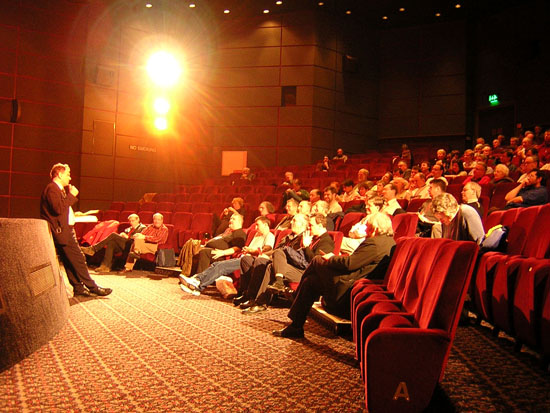 10:15 –
“This is Cinerama” (2:20) in three strip Cinerama and 7-track magnetic stereo on the curved screen. Didn’t see the film, but used the opportunity to study how Cinerama is projected for an article for Cinemeccanica. 10:15 –
“This is Cinerama” (2:20) in three strip Cinerama and 7-track magnetic stereo on the curved screen. Didn’t see the film, but used the opportunity to study how Cinerama is projected for an article for Cinemeccanica. 13:30 – “The Lion in Winter” (2:15) 70mm. Bill Lawrence introduced the film. For a number of years he had tried to get this 70mm print for the festival, however, due to uncertainty of the movie rights, the depot would not release the print. In the end the rights holder turned out to be Studio Canal+, and they were delighted to have the film shown for 500 Pounds. Bill then gave the microphone to Mark Lyndon, who proclaimed the Widescreen Weekend to be the finest film festival in the world. A statement which made the audience applaud and cheer. Filmed in Eastmancolour, Panavision and blown up to 70mm for the London re-issue November 8, 1973. 70mm print shown in 6-track magnetic stereo on the curved screen. The print, faded and very brownish, had the overture, intermission and entr’acte intact. During the intermission words like “panel”, “70mm” and “curve” were heard among the audience. |
||||||||
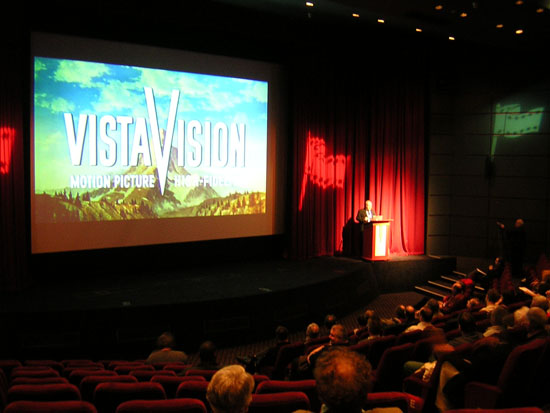 16.00 - Tom Vincent lecture on VistaVision.
I didn't attend, but some members of the audience thought Tom spoke too fast. Despite the
fascinating subject it was very difficult to understand.
16.00 - Tom Vincent lecture on VistaVision.
I didn't attend, but some members of the audience thought Tom spoke too fast. Despite the
fascinating subject it was very difficult to understand. April 14, 2004 Dear Thomas, I've just read some of the comments about this year's Widescreen Weekend on your excellent website. I'm a bit concerned if some people didn't understand my talk on VistaVision, so please could you put the following on your website? "All the feedback I've personally received about my talk on VistaVision has been very positive. However, I'm sorry if some people thought I spoke too fast. I must admit, I did feel afterwards that I rushed it a bit, but I think in the circumstances it was unavoidable - the day's programme was well over half an hour behind schedule and I didn't want to delay it any further! It now looks like that some of my work on VistaVision is going to be published in a book, so please watch out for any announcements." Thanks! All the best, Tom |
|
|||||||
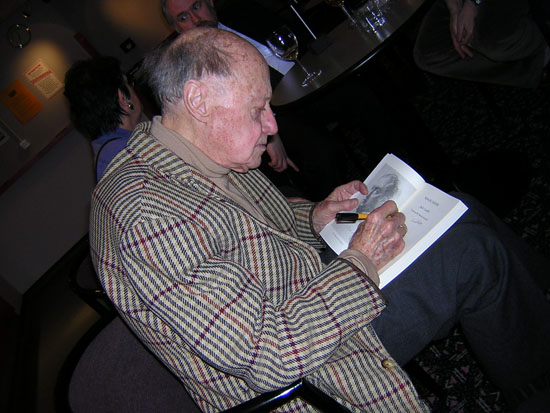 Jack
Cardiff signign autographs Jack
Cardiff signign autographs17:00. This years reception for the Widescreen Delegates took place in the expanded Pictureville bar. It took a while before everyone got his or her drink. Many complained about the long queue. Only one poor girl behind the desk to serve more than 80 people. People want to talk, so next year its back to the original room on the fourth floor. Hooray. 17.50 – “Vertigo” (VV) Filmed in Eastmancolour, VistaVision and blown up to 70mm for the restoration re-issue October 4, 1996. 70mm print shown in 6-track digital DTS sound on the flat screen. 20.15 – “Lord Jim” (2:34). Filmed in Eastmancolour and Super Panavision 70. Originally released February 15, 1965 in London. New 70mm print shown in 6-track Dolby SR magnetic stereo on the curved screen. This was a smashingly good-looking new 70mm print with an intermission. I have once seen it on pan-and-scan TV and remembered it to be boring and was now curious to see it again, as originally intended on a very wide screen. Well, I can only say it WAS boring. I even slept from time to time. Tony Sloman slept through the whole film, he told me. All things said, Columbia Pictures are to be congratulated for reprinting “Lord Jim” and making the new print available for screenings. |
||||||||
Saturday 20 March, 2004 |
||||||||
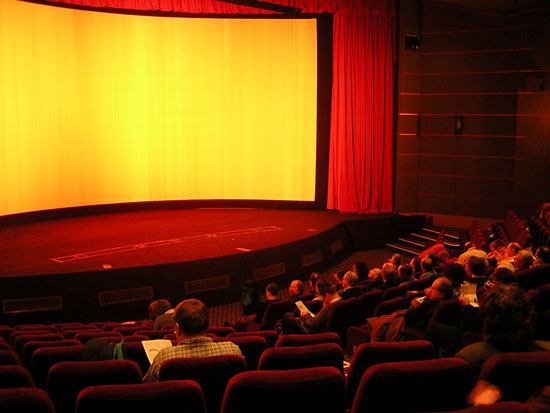 10.00 – “Cinerama's Russian Adventure“ (2:02). Filmed in Sovcolor 3-strip Kinopanorama. Originally released March 29, 1966 in Chicago. Later optically printed to 70mm. 70mm print shown in 6-track magnetic stereo on the curved screen. 10.00 – “Cinerama's Russian Adventure“ (2:02). Filmed in Sovcolor 3-strip Kinopanorama. Originally released March 29, 1966 in Chicago. Later optically printed to 70mm. 70mm print shown in 6-track magnetic stereo on the curved screen. Included sequences from: Great is my Country 28.02.1958 The Enchanted Mirror 1958 One hour of Unexpected Travels by Helicopter 1960 Fourth Programme of Panorama Films: "Circus Performance " and "On the Red Square" 1961 Naughty Curves 1961 With an Open Heart 1961 To the Antarctic for the Whales 1961 Amazing Hunting 1962 The Volga Flows On 1963 The film was co-introduced by Bill Lawrence and Ramon Lamarca. The story of this screening is interesting. Mr. Ramon Lamarca, of Spanish origin and now working in London, has spent nearly a year looking for 70mm prints in Spain and South America for the Widescreen Weekend. The Argentinean film museum in Buenos Aires has a collection of films and memorabilia - and a 70mm print of “Cinerama's Russian Adventure”; however, they were unable to run it. So they offered the museum a 70mm print of “Cinerama's Russian Adventure” for 1000 pounds. Friends of the museum came to help financially to buy the print. The following people contributed to the payment for the Argentine 70mm print: John Belton Malcolm Clarke Richard Greenhalgh Andrew S King Chris O’Kane Anders Olsson Peter Philips Howard Rust Allan Young |
||||||||
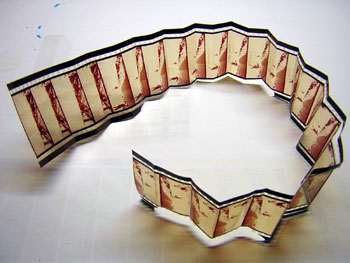 The print turned out to be rubbish, smelled terribly of vinegar and was impossible to run.
It had actually shrunk so much it could not go into the splicer. Ramon has
written a 3-page letter to the museum in Buenos Aires get the money back -
but so far no reply.
The print turned out to be rubbish, smelled terribly of vinegar and was impossible to run.
It had actually shrunk so much it could not go into the splicer. Ramon has
written a 3-page letter to the museum in Buenos Aires get the money back -
but so far no reply.Through the aid of Widescreen Weekend Academy member Willem Bouwmeester, another runnable 70mm print was retrieved from a person in Holland, who received hearty applause (70mm print donated to the museum). Finally, Bill said someone told him he was missing the usual cock-ups of the weekend – as it was all going too smooth. More applause to Ramon for his work and then the film began. The film itself was extraordinarily interesting, as it had several scenes from Russian life filmed daringly by the Russians with their monstrous 3-panel Kinopanorama camera. Scenes included scenes from the Moscow metro trains, whale hunting in the Arctic, circus performing including a very young world renowned clown Mr. Oleg Popov, spectacular river rafting and the usual (boring) ballet scenes. There were two breakdowns during the performance, but considering the age of the print, it's a miracle there weren't more. |
See the poster | |||||||
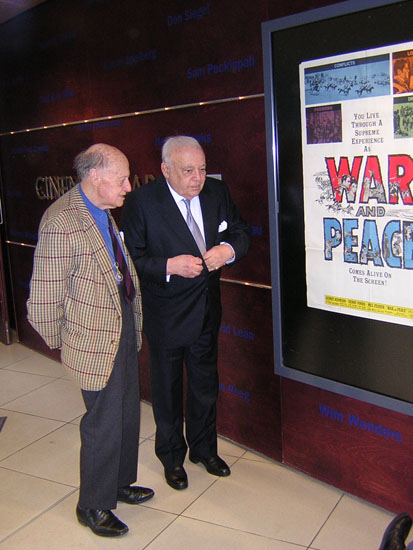 13.30 – “War and Peace” (VV).
I didn't see the film - but the print was a 35mm IB Technicolor print with
many splices and scratches. 13.30 – “War and Peace” (VV).
I didn't see the film - but the print was a 35mm IB Technicolor print with
many splices and scratches.16.30 - Screen talk: Jack Cardiff & Herbert Lom Both gentlemen on stage with moderator Bill Lawrence. Mr. Herbert Lom reminisced about the production of "War and Peace". One particularly funny story was about Henry Fonda complaining about a script, and if the line could be changed. "It doesn't sound real" Fonda told producer DeLaurentis, who replied to him, "No Hank, it's a movie - get on with it". Generally Herbert Lom mostly remembered the silly things in such a serious business. Sheldon Hall from the audience asked Herbert how he would rate "War and Peace", and the reply was "I don't rate it at all". Jack made the audience roar with laughter with a story about actress Anita Ekberg's bosom and a blackout in a lift. Jack was to shoot some still pictures of Anita who was a very tall and world-reknown for her considerable bosom. She came to his flat for the photo session and Jack took her up in the lift. Since Jack is relatively short, and Italian lifts are very small there was just room for both in the lift. Imagine Jack staring right into Anita's bosom - and then the lights went out! He was standing there in this very confined lift literally with his face buried in Anita's bosom for 15 minutes. Ah, the perils of a working photographer! |
||||||||
|
|
||||||||
Sunday 21 March, 2004 |
||||||||
Cineramacana and the Audience on Stage |
||||||||
|
||||||||
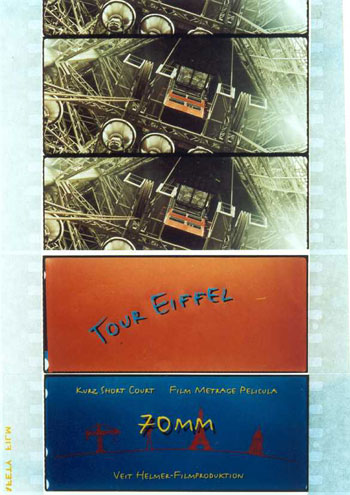 Cineramacana Program
2004 Cineramacana Program
2004Start 10:10 - end 12:50 35mm VistaVision promotion film 3 x 35mm trailers 35mm "Grease" 70mm "Tour Eiffel" 70mm "Fanny´s Wedding" 2 x Beta SP "Look at Life" 70mm "Fantastic Flights" 70mm "Aliens: Ride at the speed of Fright" 70mm "A Year Along the Abandoned Road" Widescreen Academy Presentation Audience on Stage photograph Start 10:10 - end 12:50 35mm VistaVision promotion film in Technicolor starring would-be singer Oresti. The film was found in a flea market for 40 EUR. Provided by Mr. Johan Wolthuis and introduced by Mr. Rolof de Jeu. Shown on the flat screen with the Victoria 8. Tony Sloman provided the outro and told the audience more about Mr. Oresti. 3 x 35mm trailers, "The Pride and the Passion" (Technicolor), "War And Peace" and "The Alamo" (Technicolor) provided and introduced by Mr. Hans Helf. Shown on the flat screen with the Victoria 8. 35mm mono, opening titles and first song from "Grease" provided and introduced by Mr. Tony Sloman. Shown on the flat scren with the Victoria 8. Tony also provided the outro while the projector was set up for 70mm. Stop and relace 70mm "Tour Eiffel" (0:10) by Veit Helmer. Introduced by Bill Lawrence and shown on the flat screen with the Victoria 8. Absolutely gorgeous images and wonderful 6-track magnetic stereo. Takes place in Paris and displays MAJOR production logistics. Veit Helmer makes really strange films, and "Tour Eiffel" is probably his most accessible work to date. "Tour Eiffel" was also shown at the very first Widescreen Weekend in 1995. |
||||||||
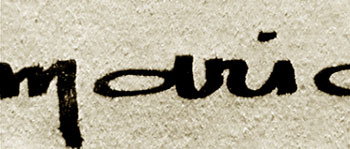 70mm "Fanny´s Wedding" by Olivier Brunet.
Introduced by Ramon Lamarca and shown on the flat screen with the
Victoria 8. Absolutely gorgeous images and wonderful 6-track DTS
stereo. Really demonstrates the quality of 70mm even when the images are
degraded intentionally - exceptional contrast.
70mm "Fanny´s Wedding" by Olivier Brunet.
Introduced by Ramon Lamarca and shown on the flat screen with the
Victoria 8. Absolutely gorgeous images and wonderful 6-track DTS
stereo. Really demonstrates the quality of 70mm even when the images are
degraded intentionally - exceptional contrast.2 x Beta SP "Look at Life" introduced by Steve Smith (Carlton International). Two of the most famous short films from the 1960s about the English movie industry: "The Cinema Steps Out" and "A City Built for Shooting" (About the filming of "55 Days at Peking"). |
||||||||
Curved screen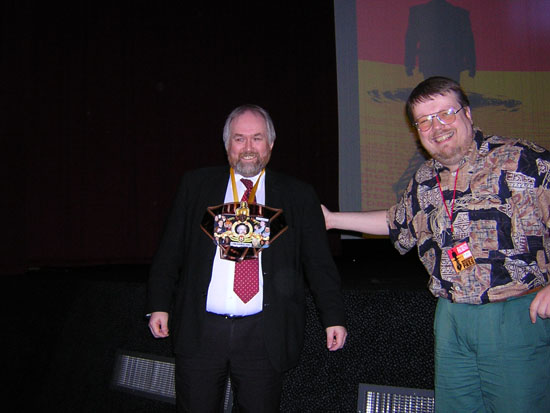 Award to Bill Lawrence from the German delegation headed by Hans
Helf "Master of Disaster", sorry "Master and
Commander" as he said. Bill received an award in the form of a
bootleg DVD about Bradford and a 70mm film "medallion".
Award to Bill Lawrence from the German delegation headed by Hans
Helf "Master of Disaster", sorry "Master and
Commander" as he said. Bill received an award in the form of a
bootleg DVD about Bradford and a 70mm film "medallion".70mm "Fantastic Flights" provided and introduced by Mr. Paul Rayton. This was shown on the curve and seemed to be enjoyed by the audience. Typical 1980s Cinema-180 short film of roller coasters and airplanes. Erick Akers of US origin had lent it to Paul. 70mm MotionMaster "Aliens: Ride at the speed of Fright". Intercut with footage from "Aliens", this ride film was also shown on the curve without moving seats. It was provided and introduced by Darren Briggs. Stop and relace |
||||||||
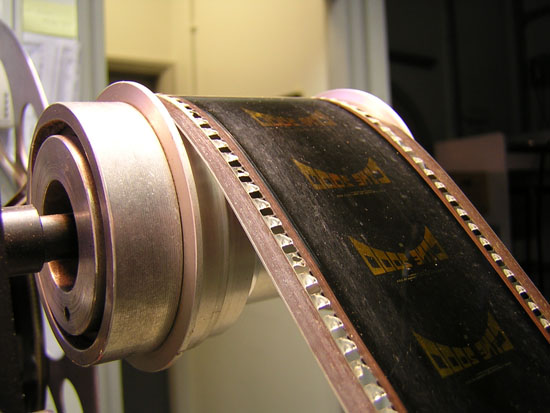 70mm "A Year Along the Abandoned Road" Introduced
by Thomas Hauerslev and shown on the curved screen with the DP70.
Again, absolutely gorgeous images and wonderful 6-track magnetic
stereo. 70mm "A Year Along the Abandoned Road" Introduced
by Thomas Hauerslev and shown on the curved screen with the DP70.
Again, absolutely gorgeous images and wonderful 6-track magnetic
stereo. Next the audience was told to keep their eyes open and watch carefully as a "70mm film quiz" was about to start. I spotted 70mm clips from two intros for "First Blood" and then "The Right Stuff", ?, "The Mission", "The King and I", "Khartoum", "Custer of the West" and "Aliens". As nobody in the audience apparently had the correct answer, the correct list was never revealed. We all have to wait until 2005. Bill Lawrence took the microphone and introduced the projectionists, for appreciation and enthusiastic applause from the audience. |
||||||||
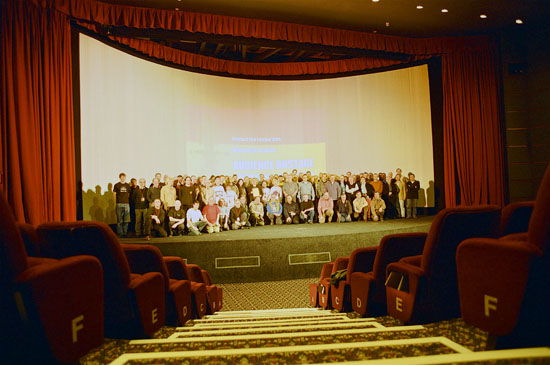 Widescreen Academy Presentation. This years award went to
Anthony (Tony) B. Sloman for his services to the industry
in general and to the
Widescreen Weekend in particular.
Widescreen Academy Presentation. This years award went to
Anthony (Tony) B. Sloman for his services to the industry
in general and to the
Widescreen Weekend in particular.Audience on Stage photograph. An innocent idea started in 1997 just outside the cinema, some of the audience got together to take a photograph. The idea developed and more joined in. Since 1998, a picture has been taken of the audience on stage in front of the huge Cinerama screen. As usual, Paul Rayton stage-managed the people on the stage the best he could while yours truly took the picture. |
||||||||
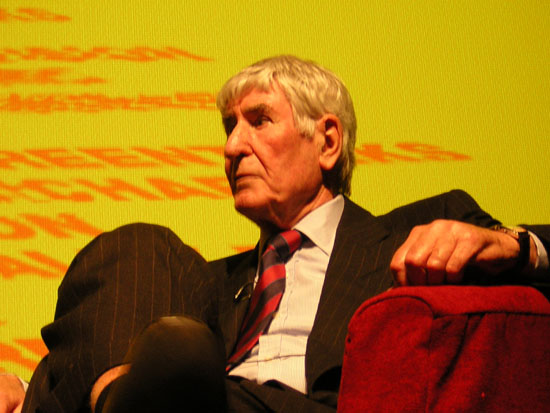 13.00 – “Hamlet” (4:02) 70mm.
Filmed in Eastmancolor and photographed in Panavision System 65. Originally released December 25, 1996
at the Paris Theatre in New York (USA). A good 70mm print shown in 6-track Dolby
A magnetic stereo on the flat screen. Performance ended 17:40. 13.00 – “Hamlet” (4:02) 70mm.
Filmed in Eastmancolor and photographed in Panavision System 65. Originally released December 25, 1996
at the Paris Theatre in New York (USA). A good 70mm print shown in 6-track Dolby
A magnetic stereo on the flat screen. Performance ended 17:40. The image was very sharp and the film looked absolutely stunning. The Dolby A 6-track magnetic sound (Format 43 - stereo surround) sounded fantastic - so rich. It was nice to see a modern 70mm print so incredibly sharp. Vibrant colours and great contrast. Alex Thomson introduced the film told the audience that Kenneth Branagh had seen "Lawrence of Arabia" in 70mm and felt "Hamlet" should be filmed in 65mm. It was quite difficult to finance as the budget was relatively small. However, thanks to Panavison, Technicolor and Kodak, it all came through and the film was shot during 9 weeks and 2 days in 65mm Panavision System 65. Most of the budget went into building the large main hall seen in most of the film. "Hamlet" announced in 70mm A Visit to the Set 1997 reviews 17.00 - Masterclass: Alex Thomson. After a short break, slightly behind schedule, Bill Lawrence introduced Alex Thomson on stage for a discussion about his work. Alex Thomson (Age 75) is now retired from photographing films and now edits the BSC Newsletter. He told the audience how difficult it was to shoot "Hamlet" because of all the mirrors and the 360 degree pans. The camera was always on the move and the movements had to be coordinated with the dialogue. Which, as we all know, there is a lot of. In Shakespeare's world something as simple as saying "Pass the salt" takes 4 pages. Other clips on video included "Dr. Phibes Rises Again", "Excalibur" and "Cliffhanger". |
||||||||
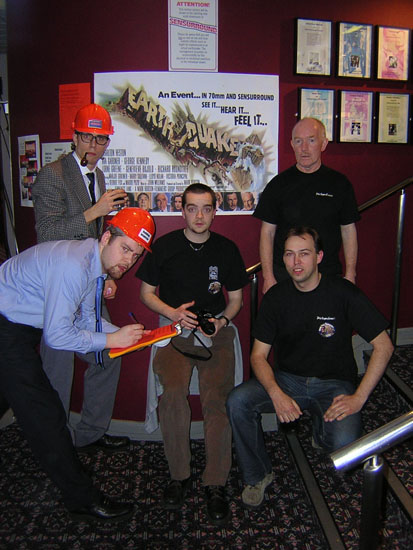 From Left to Right:
Richard Masara (Prof Farnsworthy), Howard Mosely (Oliver Crack- Building inspector!),
Adam Johnston (Helper out for the event, 70mm fan), Bill Thomson - standing
- (City Screen York Projection team) Darren Briggs
- sitting on stairs - (Technical Manager City Screen LTD) From Left to Right:
Richard Masara (Prof Farnsworthy), Howard Mosely (Oliver Crack- Building inspector!),
Adam Johnston (Helper out for the event, 70mm fan), Bill Thomson - standing
- (City Screen York Projection team) Darren Briggs
- sitting on stairs - (Technical Manager City Screen LTD)18.00 – “Forbidden Planet” in Perspecta Sound + lecture by Mr. Dion Hanson 18:00 ”Apollo 13” + ”Where the Trains used to Go” in IMAX. Missed the opportunity Thursday evening to see both films as the trains connected rather badly from Manchester Airport to Bradford. Saw Morten´s film and then left “Apollo 13” 20.30 – “Earthquake” 70mm. Filmed in Eastmancolor, Panavison and blown up to 70mm for several European key markets during the original release which includes London, England (November 28, 1974) and Copenhagen, Denmark (January 31, 1975). 70mm print shown in 6-track magnetic stereo and Sensurround on the curved screen. Much anticipated was the Sensurround performance of "Earthquake" in 70mm. Darren Briggs and his colleagues from the York cinema gave a splendid performance which lived up to the best tradition of SHOWMANSHIP. Before the film they had set up a poster from the film and handed out "My Last Will" to the audience. Two actors, playing engineers were entertaining the audience before the show. They all wore t-shirts saying "An Event - in70mm and Sensurround". During the film they used strobe lighting effects and pumped in smoke during rumble scenes to add to the illusion of a real earthquake. They are truly the Mike Todds of today, somebody remarked after the film. Their efforts to make the show an event were highly praised. In fact the audience responded with a huge applause after the film. |
||||||||
Monday 22 March, 2004 |
||||||||
|
10.30
– “55 Days at Peking” 70mm (in French). Filmed in
Eastmancolor, Technirama and optically enlarged to 70mm and presented in
Super Technirama 70 during the original release which included London,
England (May 6, 1963). 70mm print shown in 6-track magnetic stereo on the
curved screen. |
||||||||
|
Go: back
- top - back
issues - news index Updated 22-01-25 |
||||||||

